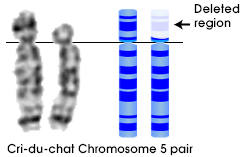Cri-Du-Chat Syndrome

Description: The picture shows which part of Chromosome 5 is missing. This is what causes Cri-Du-Chat Syndrome.
Image copyright: http://images.google.com/imgres?imgurl=http://learn.genetics.utah.edu/units/disorders/whataregd/cdc/images/cri-du-chat_diagram.gif&imgrefurl=http://learn.genetics.utah.edu/units/disorders/whataregd/cd
Cri-Du-Chat is a genetic disorder that causes mental retardation and deformation. Cri-Du-Chat is a somewhat rare condition that only occurs in around 1 to 25,000 to 1 to 50,000 births. Cri-Du-Chat affects both males and females, but seems to affect females more often. In 1963 Jerome Lejeune, a geneticist, discovered cri-du-chat syndrome. He also discovered the genetic abnormality that causes Down syndrome.
Symptoms/Characteristics
Some symptoms associated with Cri-Du-Chat are: low birth weight, a cat-like cry, mental retardation, heart defects, seizures, and abnormal facial features (such as wide-spaced eyes, low-set ears and small head size). Not all children with this disorder have all of these symptoms. The circulatory system (heart) is affected because some infants have heart defects. The nervous system (brain) is affected because they are mentally retarded and are learning disabled, and have limited motor skills.
Genetics
Cri-Du-Chat is a genetic disorder that is caused when parts (genes) of chromosome 5 are missing, which usually causes mental retardation and other health problems. This disorder is not related with any specific ethnic background. In other words people of any ethnicity could be born with this disorder. Cri-Du-Chat is not inherited in most cases.
Treatment /Prevention
There is no cure or specific treatment for cri-du-chat, but early intervention programs, such as speech therapy, can help with early development. Cri-du-chat syndrome can not be prevented.
